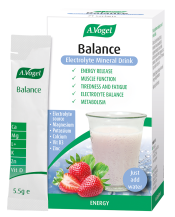Potassium and bloating – what’s the connection?
Abdominal bloating can make your abdomen (the area between your chest and pelvis) feel full, tight, and tender, and may cause your belly to look larger than usual. This can be down to a number of factors, for example, a build-up of gas in the gastrointestinal tract, or an intolerance to certain foods.
You may be unaware, however, that potassium intake can play a role in bloating. There are a number of factors which must be considered in order to understand why this is, including:
- The relationship between potassium and sodium
- How a low potassium intake can contribute.
Read on to find out how potassium intake affects bloating, and get some tips on how to increase your potassium intake.
The relationship between potassium and sodium
Potassium has many important roles within the body, including helping to send nerve signals and regulating muscle contractions. However, it is potassium's role in regulating fluid balance which is thought to play a part in reducing instances of bloating.
Potassium can reduce bloating by decreasing water retention in the body. Water retention, also known as fluid retention or oedema, occurs when excess fluid builds up in the circulatory system, or within tissues and cavities.
Potassium reduces water retention by removing excess sodium (salt) from the body. To understand why this is, we must take a look at how our cells are affected by our intake of potassium and sodium.
Under normal circumstances, intracellular fluid (fluid inside the cell) contains higher levels of potassium, and lower levels of sodium. Extracellular fluid (fluid outside the cell), on the other hand, contains lower levels of potassium, and higher levels of sodium. Potassium and sodium maintain this equilibrium via a pumping mechanism in the cell wall. It's a little like a seesaw: you have to have the right quantity at each end in order to maintain the balance.
If you have a diet which is high in salt (sodium chloride), such as one containing lots of processed foods like ready meals and takeaways, this can overwhelm the sodium end of the seesaw, causing more sodium to be pushed inside the cells, whilst potassium is pushed out. As water tends to follow sodium, this can result in fluid retention, as the cells hold onto an excess of water.
When this happens, it can result in a bloated appearance, specifically if fluid is being retained around the abdomen.
In addition to this, when sodium moves inside cells, the concentration is reduced in the extracellular fluid, which can make your body think that it is actually lacking in sodium. Therefore, you are likely to crave more salty foods; and eating these is likely to worsen the problem!
However, if you increase your potassium intake by including potassium-rich foods in your diet, this helps to rebalance your levels of sodium. More potassium will be pushed inside cells, allowing sodium and water to leave cells and be excreted from the body.
How does low potassium intake affect bloating?
As previously mentioned, potassium is required for numerous vital roles within the body, and one of these important roles is to help relay signals from the brain to the gut.
Potassium helps to communicate messages from the brain to muscles located in the digestive system. These messages tell the muscles in the digestive system to contract, which helps to break up food and allow it to be digested efficiently.1
However, when levels of potassium in the body are low, the brain is unable to communicate these messages as efficiently. As a result of this, contraction of muscles in the digestive system may become weaker, slowing the movement of food. This may result in digestive issues such as bloating, constipation and abdominal discomfort.2
As previously touched on, if your diet is low in fresh, potassium-rich foods such as fruits, vegetables and nuts, and perhaps your intake of processed foods, and other foods containing a lot of salt, is higher, your potassium levels could be rather imbalanced. And, as previously described, this can result in bloating.
A.Vogel Balance Electrolyte Mineral Drink with Vitamin D3, Magnesium, Zinc, Potassium and Calcium.
£22.49 (21 x 5.5g sachets) In Stock
How to increase your potassium intake
To increase your potassium consumption, include fruit such as oranges, melons and bananas, and vegetables like broccoli, tomatoes, potatoes and squash in your diet regularly. Nuts are also a good choice.
Your cooking techniques can also play a part in the potassium content available in foods. For example, steaming veggies instead of boiling them can help to retain more potassium.
Moreover, cooking techniques can play a big role in how much salt you add to your food. If you add salt to your food during the cooking process, the flavour can wear off whilst you cook, meaning that you have to add more salt once it is ready!
My top tip would be to only add salt after tasting the meal. This way you aren't adding loads of additional salt, plus you can tell how much or little salt the dish requires. As stated above, reducing your salt intake, and increasing your intake of potassium-rich foods, can work wonders on a bloated stomach!
Whilst potassium is an essential nutrient for health, consuming too much can be dangerous. In my blog "4 health benefits of potassium", I explain in detail what can happen if your intake of potassium is too high, so please refer to this if you have any concerns.
References
1 https://www.ncbi.nlm.nih.gov/pubmed/11260359
2 https://www.ncbi.nlm.nih.gov/pubmed/22965426









